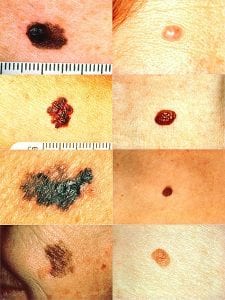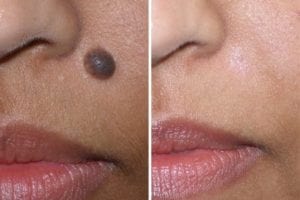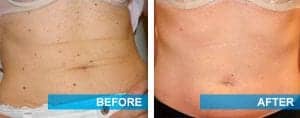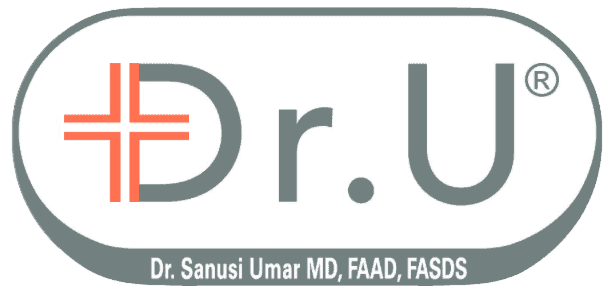Best Mole Removal Services Los Angeles: Are you in need of mole removal services? Look no further. Dr. U is happy to address all of your questions, concerns, and treatment options, such as laser mole removal. Known as one of the best mole removal services in Los Angeles, Dr. U is here to help.
Reasons for Mole Removal: People seeking mole removal vary from case to case. While some seek out affordable mole removal services for aesthetic reasons, others need mole treatment due to skincare concerns.
Mole Removal? Or Cancer? After a complete body examination with Dr. U, each mole can be checked for skin cancer. Taking in warning signs such as asymmetry, border, and color of the moles, Dr. U can spot suspicious-looking moles.
What is a Mole?
A mole is a growth on your skin that is typically brown or black and can be found anywhere on your skin, by itself or in groups. Most moles will appear during early childhood and in the first 30 years of someone’s life. People tend to have anywhere between 10-40 moles by the time they’re an adult, which can be unsightly and include hair growing within. After 40, any new mole should warrant close attention and evaluation by a certified dermatologist. Over time, a mole can slowly change, becoming raised or changing in color. Some moles may disappear over time, allowing the individual to avoid mole treatment. While moles have the potential to change, not all of them do.
What Causes Moles?
There are two things that may cause moles to form:
- Sun exposure
- Hormonal changes (e.g. puberty, pregnancy, menopause, and taking hormone medication)
Moles form when melanocytes, a specialized kind of cell that produces melanin, grow in clusters with tissue surrounding them. These pigmented cells frequently appear as small, dark brown spots. Moles can form on the area of the body, which means that mole removal services are used head to toe. They come in different shapes and sizes and can be flat or raised, smooth or creased. While you may notice more and more moles popping up on different areas of your body with time, you can also experience the opposite- moles disappearing with age. While most moles are harmless, it is always a good idea to check with a doctor for pre-cancerous signs. If this is the case, mole removal services are available.
Types of Moles

All kinds of moles are categorized by their shape, color, and texture. Fortunately, mole treatment can address all of them.
- Regular and Irregular Moles: Regular moles are either circles or ovals. They tend to be symmetrical, while irregular moles are asymmetrical.
- Brown, Black, Red, and Flesh Colored Moles: Brown and red moles are present in people with lighter skin, while black moles usually appear in dark skin. Flesh-colored moles typically appear on people of African descent. Although moles are usually benign, if they are exposed to powerful UV rays, it can set off DNA processes that lead to skin cancer. Red moles tend to have higher risk factors.
- The raised and Flat Moles: The mole is raised, or flat will depend on where the melanocyte clusters exist relative to the skin layers. A mole is just a lesion (abnormal tissue formations). Due to the clustering of melanocytes, scientifically, they are called melanocytic nevi. There can be different variations of melanocytic nevus. These classifications include:
- Junctional Nevus: The junctional nevus is found at the outskirts of the epithelial skin surface and the dermal skin underneath. This kind of mole is brown or black with a flat texture.
- Intradermal Nevus: The intradermal nevus is only found in the dermis. These kinds of moles usually have a flesh color and appear raised.
- Compound Nevus: Compound nevus moles are raised with a brown or black color. People commonly refer to this as a beauty mark. The melanocytic clustering starts forming at the epithelial and dermal juncture and the dermis. It is a hybrid of a junctional and intradermal nevus.
- Dysplastic Nevus: The dysplastic nevus is two kinds of nevus. However, the cells of this nevus are strangely developed along with its overall architectural configuration. This mole tends to be bigger than average. The mole appears flat or raised. The border and color may look irregular, similar to cases of melanoma. If they often appear in number, they should be examined.
- Blue Nevus: The blue nevus takes this color because the melanocytes responsible for it are located deep within the dermis. The cells have the shape of a spindle. Instead of being clustered, they are scattered.
- Spitz Nevus: The spitz nevus is a kind of intradermal nevus. This mole tends to be red as well as raised.
- Congenital Nevus: This kind of mole will be present at birth and happens in about 1 out of 100 babies. Unfortunately, this nevus type carries a high risk of developing melanoma.
- Acquired Nevus: This nevus is acquired during the later stages in life. The melanocytes that cause this nevus can be junctional, compound, or intradermal.
- Giant Pigmented Nevus: The giant pigmented nevus is a pretty large pigmented area that can have some prolific hair growth. Melanoma happens in 10-15% of cases.
Examining Moles
According to the University of Maryland Medical Center, most moles are not cancerous. An examination is necessary to make sure that the mole is not cancerous.
The A B C D E criteria are often used to analyze various characteristics of moles roughly.
- A – represents asymmetry. Most moles will be symmetrical.
- B – stands for border. It’s recommended that fuzzy or smudged edges on a mole be looked at as possible warning signs.
- C – stands for color. Benign moles usually have the same color. A physician should look at distinctive colors.
- D – stands for diameter. If a mole is more significant than the size of a pencil eraser or around 7mm, it should be further examined.
- E – stands for evolution and elevation. Check for any irregularities in height, looking for parts of the mole that are higher than the other. It’s also a good idea to note any changes in how the mole changes in time.
How To Remove a Mole
Los Angeles Best Mole Removal Services: When it comes to mole removal services, there are three standard techniques for eliminating nevi:
Surgical Mole Removal
Mole removal services can be done by cutting the moles off their base or by excising the skin around the mole. Making cuts under the mole usually means sutures aren’t necessary. However, cutting around the mole may require sutures after the procedure. Cutting a mole and suturing can leave a line of scars, but cutting without suturing may leave a wider spot. After the mole has been removed, it should be given histological analysis to determine the specific nature and checked for cancer cells.
Cryotherapy
Liquid nitrogen is typically placed onto the skin with this type of mole removal treatment. It then freezes the mole to get rid of the abnormal tissue. When the melanocyte cluster is deeply embedded inside the skin, needles or probes can be used to apply the nitrogen. Chances of color loss are increased with cryotherapy.
Mole Removal By Laser
Laser mole removal Los Angeles: When receiving mole treatment by laser, specific laser wavelengths can be absorbed by the mole’s pigment. The energy of this wavelength is used to destroy the abnormal tissue. The laser then seals off blood vessels so that there is no bleeding after the procedure.
Laser mole removals are done only for benign lesions. It must not be done in malignant or cancerous lesions or lesions suspected to be cancerous or have the potential for cancerous transformation. A mole with cancerous characteristics should be removed with surgery and submitted for pathologic analysis.
Before and After Photos of Mole Removal Services Los Angeles
Facial Mole Removal

Thanks to facial mole removal, this patient achieved the cosmetic look she was after.
Skin Mole Treatment

While this patient had a lot of moles covering her stomach, she was able to reduce the amount thanks to skin mole treatment significantly.
Seeking Mole Removal Services in Los Angeles
Best Mole Removal in Los Angeles: If you are interested in seeking mole removal services, you have come to the right place. After a consultation, Dr. U will provide a personalized treatment plan. Contact us by filling out the consultation form or call us at (310) 318-1500 to schedule an appointment.
Mole Removal Services FAQ
Does mole removal cream work?
The medical evidence does not show that this mole treatment is effective. In addition, they are usually expensive and contain harsh chemicals.
Does getting a mole removed hurt?
Most patients say that mole treatment is not a painful process, as the doctor will numb the area before removal.
Does mole removal leave scars?
This can vary depending on the mole removal treatment you have done. However, most treatments with Dr. U offer great cosmetic results.
Are stitches required following mole removal treatment?
While laser mole removal treatments do not require stitches, surgical mole removal may.
Will I miss time from work after receiving mole treatment?
No. You can resume your regular schedule immediately after mole treatment.
Will my insurance cover mole removal services?
While it varies from case to case, many insurances are willing to cover a portion of mole removal services.
How much does mole removal cost?
The average cost for mole removal ranges from $100 to $500 per mole and depends on several factors, including shape, size, and location on the body. Larger ones cost more to remove. Moles in prominent areas must be emptied more delicately, which results in a higher price.
As a world-renowned dermatological surgeon, Dr. U has plenty of experience with mole removal – to ask him a question about your mole and the possibility of treatment, click the button below to access our Ask Dr. U online portal:
Further Reading
Learn about removal services for unwanted birthmarks.
Read more about the best removal strategies for unwanted facial and body hair.

